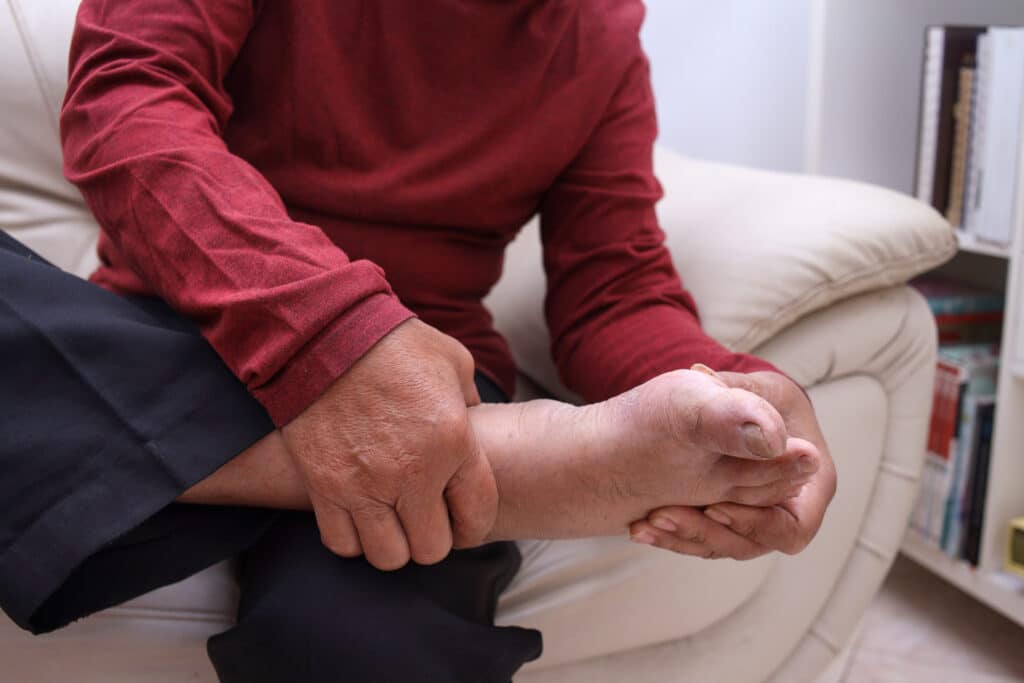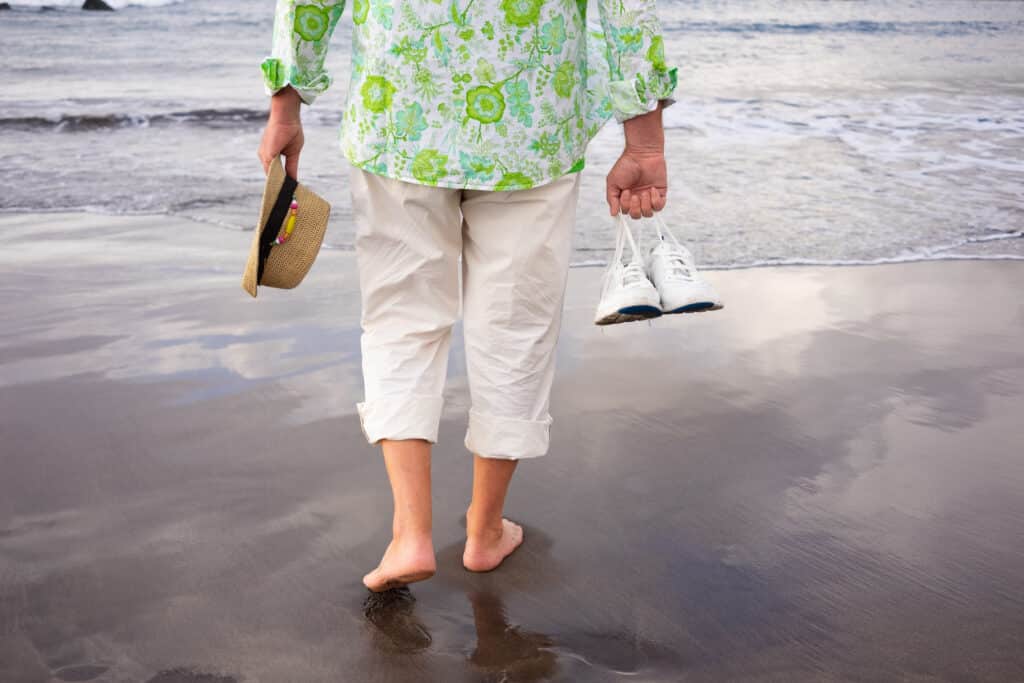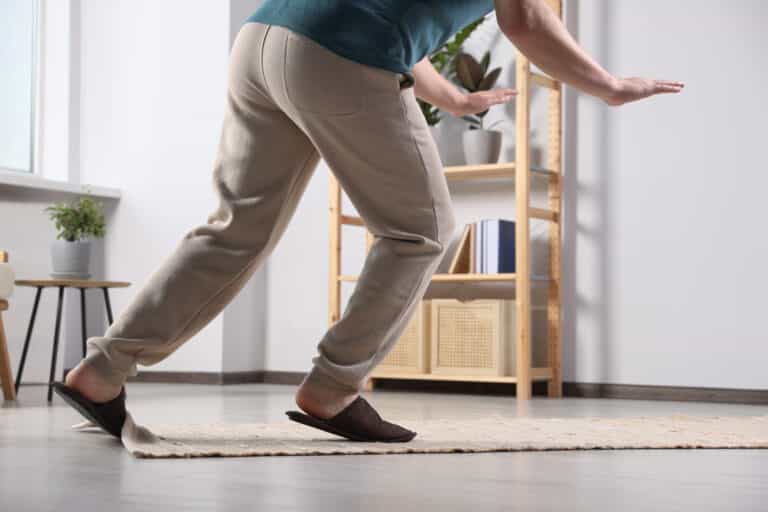Maintaining mobility and independence is one of our most important well-being priorities as we age. However, heel pain, a common and debilitating condition for many seniors, can hinder our ability to stay active and engaged in daily activities.
This article will delve into heel pain, exploring its common (and some less common) causes, the importance of accurate diagnosis, effective treatment options, and essential prevention strategies.
You can take proactive steps in managing discomfort and maintaining your quality of life. Let’s explore how you can get to the bottom of your heel pain today.
Common Causes of Heel Pain in Seniors

Heel pain can arise for many reasons, and understanding its root causes is vital in providing targeted treatment. Here are some of the main causes of heel pain in seniors.
Plantar Fasciitis
This is one of the most common causes of heel pain in seniors. Plantar Fasciitis (PF) is inflammation of the plantar fascia—a thick band of tissue that runs along the bottom of the foot, connecting the heel bone to the toes.
Over time, this condition can lead to sharp, stabbing pain in the heel, especially when taking the first steps in the morning or after prolonged rest periods.
Heel Spurs
Bony outgrowths may develop on the bottom of the heel bone due to chronic plantar fasciitis. Although not always painful, these spurs can worsen heel pain and discomfort.
Achilles Tendinitis
The Achilles tendon, located at the back of the ankle, can become inflamed due to overuse or repetitive strain. Achilles tendinitis may cause pain and stiffness in the back of the heel, making walking and other activities challenging for seniors.
Arthritis
Various forms of arthritis, including osteoarthritis and rheumatoid arthritis, can affect the feet, leading to inflammation, pain, and heel stiffness. Arthritis generally is more common in older adults, making them more prone to developing heel pain.
Bursitis
Bursitis occurs when the bursa—a fluid-filled sac that provides cushioning between tendons, bones, and skin—becomes inflamed. Seniors may experience bursitis in the heels, leading to localized pain and tenderness.
Stress Fractures
Tiny cracks in the bones can develop due to repetitive impact or overuse. Seniors with weakened bones, such as those with osteoporosis, may be at higher risk of experiencing stress fractures in the heels.
Other Conditions That Can Lead to Heel Pain
Additionally, some of the less common but possible causes of heel pain in seniors include neuropathic and inflammatory conditions, changes in foot structure, circulatory and balance issues, and other rare conditions.
- Neuropathic Conditions: Nerve-related conditions, such as peripheral neuropathy, can cause altered sensations in the feet, leading to pain and discomfort in the heels.
- Flatter, Wider Feet: Changes in foot structure, such as overly flat or wide feet, can contribute to improper weight distribution, leading to increased heel pressure.
- Circulatory and Balance Problems: Seniors with circulatory issues or balance problems may experience inadequate blood flow to the feet, increasing the risk of heel pain.
- Changes in Skin and Soft Tissues: Age-related changes in skin and soft tissues, such as reduced fat padding in the heels, can make the area more susceptible to pain and pressure.
- Heel Pad Syndrome: This condition involves inflammation of the fat pad under the heel, resulting in pain and tenderness.
- Tarsal Tunnel Syndrome: Similar to carpal tunnel syndrome in the wrist, tarsal tunnel syndrome affects the foot, leading to pain and discomfort in the heels and other areas.
- Plantar Fibroma: This non-cancerous growth of fibrous tissue on the plantar fascia can cause pain and discomfort in the heel area.
Understanding the causes of heel pain in seniors enables healthcare providers to provide targeted treatment and seniors to take preventive measures to alleviate discomfort and maintain their mobility and independence.
While this list is intended to give you a general idea of causes, it does not diagnose your pain. If you are an older adult experiencing persistent or worsening heel pain, seeking medical attention for proper diagnosis and personalized care is the first step to feeling better.
Let’s look at how you can prepare for a visit to your primary care doctor to discuss heel pain.
Steps to Determine the Cause of Heel Pain
A proper diagnosis is the cornerstone of effective heel pain management. You can expect your healthcare providers to conduct a thorough medical history and physical examination, perform imaging tests (such as X-rays, ultrasound, or MRI), and occasionally ordering blood tests to rule out other underlying conditions.
Preparing for a doctor’s appointment can help you make the most of your visit, ensuring you receive an accurate diagnosis for your heel pain and get the most out of your consultation. Here are a few tips to help you get ready for your appointment.
Document Symptoms and Pain
Before the appointment, note the nature of your heel pain, including when it started, how it feels (e.g., sharp, dull, burning), and whether anything makes it better or worse.
Keeping a pain diary for a few days can provide valuable information for the doctor.
Compile Your Medical History
This should include previous foot or heel injuries, chronic conditions, or surgeries. Also, note any medications you take, as some may contribute to heel pain.
Carrying a comprehensive list of the medicines you are currently taking, including over-the-counter drugs and supplements, will be helpful.
Note Your Footwear and Activities
It’s essential to inform the doctor about the type of footwear regularly worn and the activities that may exacerbate or alleviate the heel pain. The doctor may recommend appropriate shoe choices or modifications.
Create a List of Questions
Seniors should prepare a list of questions for the doctor during the appointment.
This may include queries about potential causes of the pain, treatment options, and preventive measures. Writing questions and concerns beforehand can help you remember to discuss them with the doctor.
Bring a Companion
Consider bringing a family member or trusted friend to the appointment. Having another person with you can provide emotional support and help you recall important information discussed during the visit.
By preparing in advance and being actively involved in your healthcare, you can ensure a productive doctor’s appointment, receive a thorough evaluation of your heel pain, and explore appropriate treatment options to improve your foot health.
How to Treat Heel Pain

Heel pain can significantly impact a senior’s mobility, independence, and overall quality of life. Fortunately, various effective treatment options are available to alleviate heel pain and help seniors regain their comfort and mobility. Here are some practical treatment approaches for heel pain in seniors.
At-Home Treatment Methods
Rest and Ice: One of the most straightforward initial measures to relieve heel pain is to rest the affected foot and apply ice. Resting the foot helps reduce stress on the injured tissues, while ice application can help minimize inflammation and ease pain.
Seniors can apply an ice pack wrapped in a thin cloth to the affected area for about 15 to 20 minutes several times daily.
Medications: Over-the-counter nonsteroidal anti-inflammatory drugs (NSAIDs), such as ibuprofen or naproxen, can help reduce pain and inflammation associated with heel pain.
Seniors should always consult their healthcare provider before starting any medication to ensure they are safe and appropriate for their health conditions.
Medical & Orthopedic Treatments
Physical Therapy: Physical therapy is essential to heel pain treatment for many seniors. A skilled physical therapist can design a tailored exercise program to strengthen the muscles and improve flexibility in the feet and ankles.
These exercises can help relieve heel pressure and improve overall foot function. Additionally, stretching exercises can reduce muscle tightness and alleviate discomfort.
Orthotics and Footwear Modifications: Customized orthotic devices, like shoe inserts or heel cups, can provide support and cushioning to the feet, redistributing pressure and reducing heel stress. Orthotics can help seniors maintain proper foot alignment and alleviate heel pain.
Healthcare providers may also recommend appropriate footwear modifications, such as wearing supportive shoes with adequate arch support and cushioning.
Night Splints: Night splints are specialized devices that keep the foot in a dorsiflexed position while sleeping. This gentle stretch can prevent the plantar fascia from tightening overnight, reducing the morning pain experienced by many seniors with heel pain.
The Last Resort: Injections & Surgery
Corticosteroid Injections: For seniors with severe or persistent heel pain, corticosteroid injections may be considered. These injections deliver anti-inflammatory medication directly into the affected area, providing significant pain relief.
However, corticosteroid injections may be limited in some cases due to potential side effects.
Surgery: Surgery may be considered in rare and severe cases of heel pain that does not respond to conservative treatments. Surgical options may include plantar fascia release, where the tight band of tissue is partially cut, or the removal of heel spurs.
Seniors must work closely with their healthcare provider to determine the most appropriate treatment plan for their condition and medical history. Combining treatments or a step-wise approach may be required to achieve optimal results.
Seniors should also follow any self-care recommendations provided by their healthcare provider, such as avoiding high-impact activities and maintaining a healthy weight, to support their recovery and prevent the recurrence of heel pain.
Remember, early intervention and adherence to treatment plans can significantly improve the outcome for seniors with heel pain, helping them regain their comfort, mobility, and independence in their daily activities.
How to Prevent Heel Pain

Preventing heel pain in seniors is crucial for maintaining mobility, reducing discomfort, and promoting overall foot health. By adopting specific preventive measures, seniors can reduce the risk of developing heel pain and enjoy an active, pain-free lifestyle. Here are some effective strategies to prevent heel pain in seniors.
Maintain a Healthy Weight and Diet
Excess body weight can put added pressure on the feet, leading to increased strain on the heels and a higher risk of developing heel pain. Seniors should aim to maintain a healthy weight through a balanced diet and regular physical activity, which can significantly reduce the burden on their feet.
Choose Supportive Footwear
Wearing appropriate and supportive footwear is essential in preventing heel pain. Seniors should opt for shoes that provide adequate arch support, cushioning, and a proper fit.
Shoes with shock-absorbing soles can also help reduce impact on the heels during walking and other activities.
Warm-Up and Stretch Before Physical Activity
Seniors should make it a habit to warm up and stretch their feet and calf muscles before engaging in physical activities or exercises.
Stretching can improve foot flexibility and prevent overloading the heels during movement.
Avoid Excessive Strain on the Heels
Seniors should be mindful of activities that place excessive stress on the heels, such as prolonged standing, walking on hard surfaces, or high-impact exercises.
Alternating weight-bearing activities with rest periods can help reduce strain on the heels.
Wear Orthotics or Custom Inserts
Custom orthotic devices prescribed by a healthcare professional can provide additional support and cushioning to the feet.
Seniors with specific foot conditions, such as flat feet or high arches, may benefit from using orthotics or custom inserts to maintain proper foot alignment.3
Stay Active with Low-Impact Exercise
Seniors should engage in low-impact exercises, such as swimming, cycling, or tai chi, to stay active without putting excessive strain on their heels. These activities can help maintain overall fitness and reduce the risk of foot-related issues.
Our Favorite Foot Stretches & Strengthening Exercises
Regular, simple foot exercises can strengthen the muscles, improve flexibility, and enhance foot function. The activities I often recommend to my patients include toe curls, toe spreads, heel raises, and calf stretches.
Toe curls
- Start with your foot flat on the floor
- Curl your toes into a “fist” until you feel slightly fatigued.
- Rest and repeat 10-12 times.
Toe spreads
- With your heel resting on the ground, lift your forefoot up slightly
- Spread your toes as wide as possible, just as you would with your fingers.
- For the greatest effect, move between the toe curl motion (listed above) and toe spreads for a full range of motion.
- Repeat for 10-12 repetitions 2-3 times a day.
Heel raises
- Standing tall with your hands on a stable surface, lift your heels as high off the floor as possible and gently set them back down.
- Repeat this motion for 12-15 repetitions or until you feel fatigued in your feet and calves.
Calf & Hamstring Stretch
- Extend one foot slightly in front of the other with the heel resting on a carpet or soft surface. Then, using the strength of your shin muscles, draw your toes toward your face until you feel a stretch in your calf and the back of your thigh.
- You can also lean slightly forward to intensify the stretch, either with a hold or with slow repetitions, as Trudie is demonstrating in the video above.
- Hold or repeat the movements for thirty seconds, then repeat on the other leg.
Incorporating these preventive measures into your daily routine can significantly reduce the risk of developing heel pain and other foot-related problems.
Regular foot care, appropriate footwear choices, and staying active can contribute to healthier feet, improved mobility, and enhanced overall well-being.
If you encounter persistent or worsening heel pain despite preventive efforts, seeking professional medical advice is essential to identify any underlying issues and receive the best treatment.
Key Takeaways
- Heel pain is common among seniors, affecting their daily life and mobility.
- A variety of causes, from plantar fasciitis to neuropathic issues, can trigger this pain.
- An accurate diagnosis is essential for effective treatment, and preparation before a doctor’s visit can aid in this.
- Treatment options range from simple at-home remedies to medical interventions, and in rare cases, surgery.
- Prevention, including supportive footwear, low-impact exercises, and regular foot stretches, plays a crucial role in avoiding heel pain.
- Early intervention and commitment to treatment plans enhance recovery outcomes, ensuring seniors’ comfort and continued mobility.
FAQs
How does aging affect heel pain in seniors?
Aging changes foot structure and elasticity, including thinning the heel’s fat pads and reduced tendon flexibility. These changes can make seniors more susceptible to heel pain due to increased sensitivity and strain.
How does diabetes relate to heel pain in older adults?
Diabetes can lead to conditions like reduced blood flow and nerve damage in the feet, known as peripheral neuropathy. This can cause altered foot sensations, potentially leading to unrecognized injuries and consequent heel pain. Additionally, fluctuating blood sugar levels can worsen inflammation, adding to the pain.
What sets plantar fasciitis pain apart from other types of heel pain?
Pain from plantar fasciitis is typically sharp and stabbing, especially noticeable during the first steps after waking up or after long rest periods. While other types of heel pain might manifest differently, plantar fasciitis pain is often more pronounced after inactivity.
When should seniors see a doctor about their heel pain?
Seniors should consult a doctor if heel pain persists for more than a week, becomes more intense, or is accompanied by symptoms like swelling, warmth, or discoloration. Early evaluation is essential to prevent potential complications and ensure timely treatment.
What happens if seniors don’t treat their heel pain?
Ignoring heel pain can result in increased discomfort, changes in walking patterns, and added strain on other parts of the foot or body. Over time, untreated heel pain can negatively affect mobility, daily activities, and overall foot health.
Resources:
- Wapner, K. L., & Parekh, S. G. (2019). Evaluation and treatment of chronic plantar fasciitis. Foot & Ankle Orthopaedics, 4(1), 1-7. https://doi.org/10.1177/2473011419896763
- Tu, P. (2018). Heel pain: Diagnosis and management. American Family Physician, 97(2), 86-93. Retrieved from https://www.aafp.org/pubs/afp/issues/2018/0115/p86.html
- Seligman, D. A., Dawson, D., Streiner, D. L., Seligman, D., & Davis, A. (2020). Treating heel pain in adults: A randomized clinical trial of hard versus modified soft custom orthotics and heel pads. Archives of Physical Medicine and Rehabilitation. Advance online publication. https://doi.org/10.1016/j.apmr.2020.10.124






